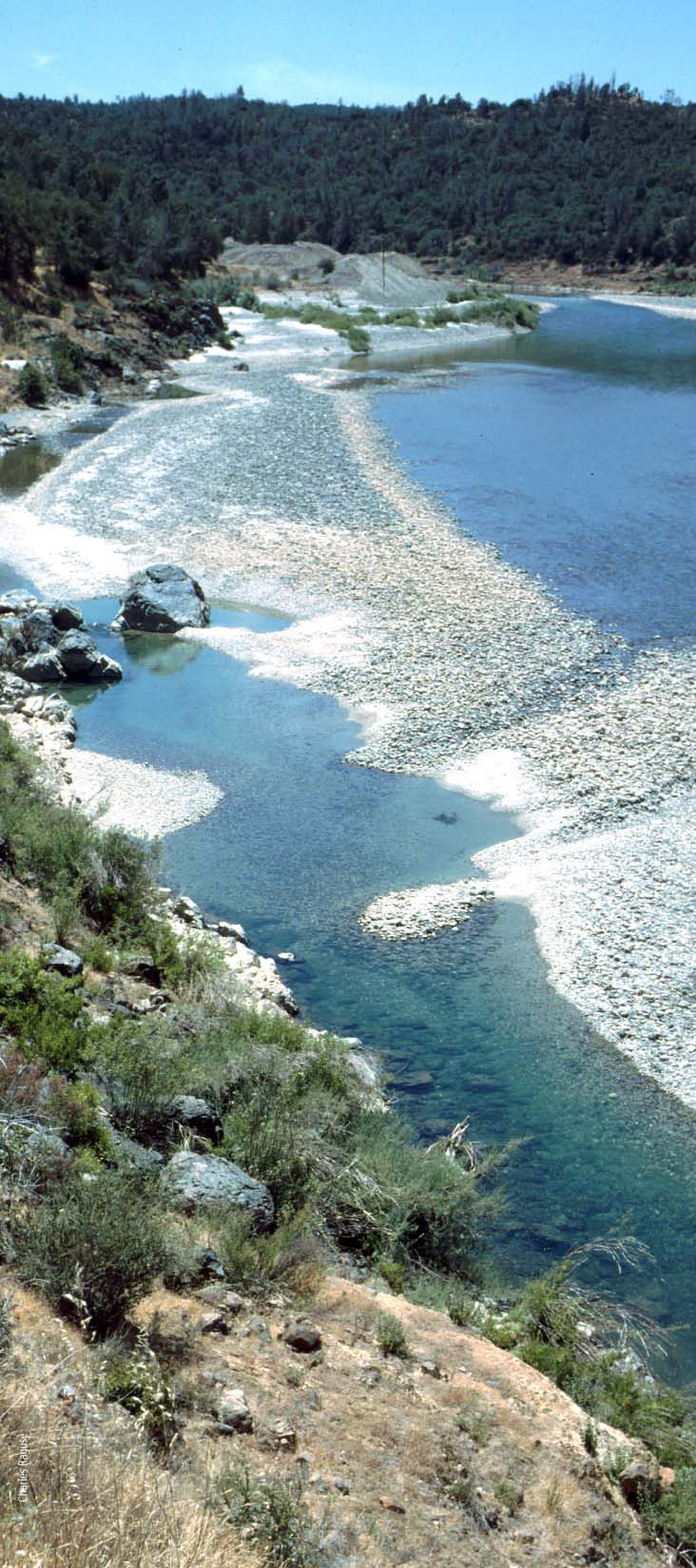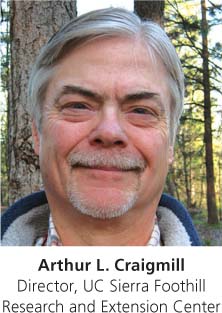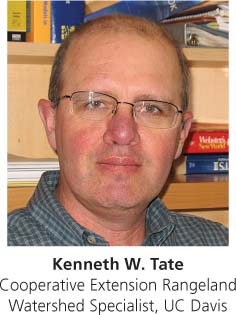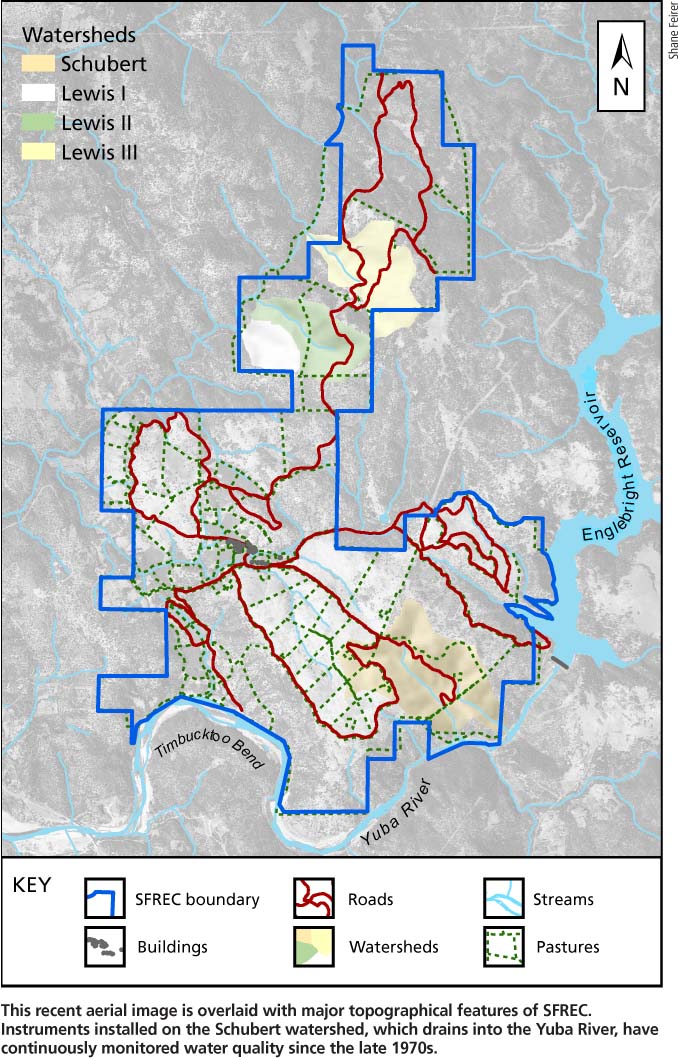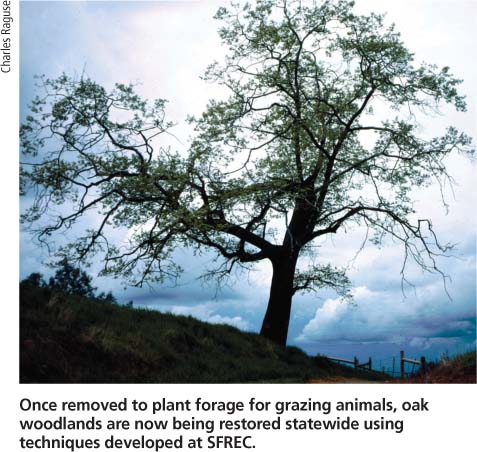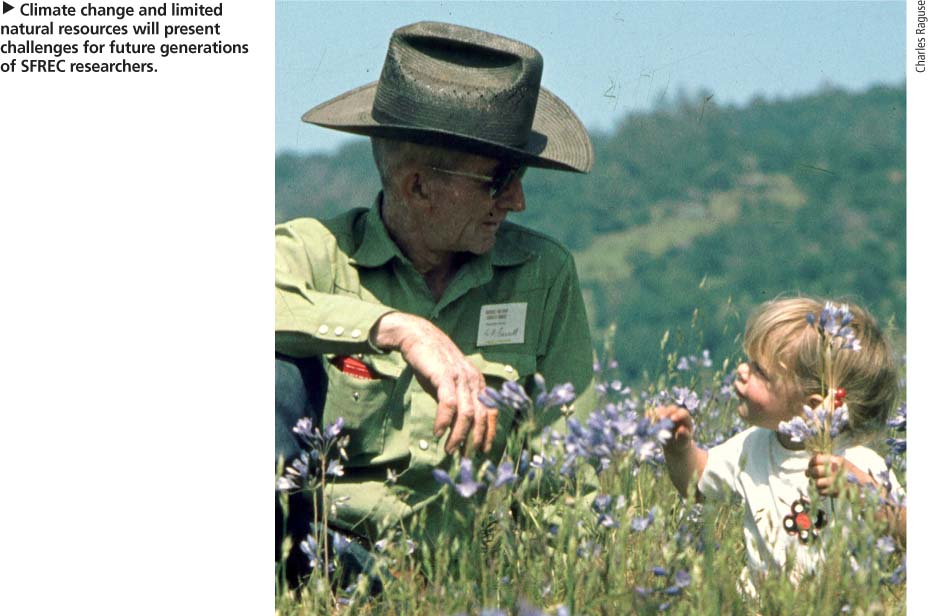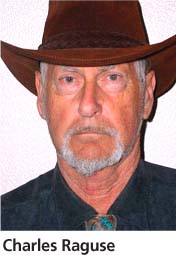All Issues
SFREC research sustains rangeland and oak woodlands
Publication Information
California Agriculture 64(2):54-56.
Published April 01, 2010
PDF | Citation | Permissions
Full text
< Facing page, the Yuba River flows along the south border of the UC Sierra Foothill Research and Extension Center.
Sixty miles northeast of Sacramento, the land rises and folds into the Sierra foothills, a trademark California landscape. Here, largely unnoticed, are 5,700 uniquely managed and protected acres — the site of landmark UC research for the last 50 years.
The story of the Sierra Foothill Research and Extension Center (SFREC) has relevance to all Californians, because rangeland accounts for more than half of the state's 101 million acres. This land not only hosts rich biodiversity and provides forage for cattle, but also forms most of the major drainage basins of the state, constantly filtering and purifying our water supply. Almost all of California's surface water, including drinking water for millions of people, passes through it.
For half a century, SFREC has advanced understanding of this vast natural resource, with its oaks, irrigated pastures, canyons, watersheds and wildlife. SFREC research has informed oak restoration, protection of water supplies, sustainable cattle ranching and wildlife restoration here and in Mediterranean ecosystems around the world. Through its research and guidelines for sustainable practices, SFREC has guided the stewards of this land, both the ranchers who own about half of these 57 million acres, and entities such as the U.S. Forest Service, regional parks and Bureau of Land Management that manage the rest.
In tribute, this issue of California Agriculture features a collection of current SFREC research. Articles discuss oak woodland restoration, salmon habitat rehabilitation, stream water and soil chemistry, the threatened California black rail (a secretive marsh bird first found here in 1994), and cattle tracking, nutrition and breeding research.
The roots of SFREC go back to 1874, when Alexander R. Forbes began raising cattle on a 160-acre homestead. During the 1900s his sons acquired neighboring properties and by the 1950s E. Floyd Forbes (Alexander's grandson, president of the Western States Meat Packing Association) had accumulated 5,014 acres, which he sold to UC in 1960. UC would acquire three more properties to complete what was then the Sierra Foothill Range Field Station.
SFREC is one of nine such UC facilities located throughout the state's diverse production and climate zones. Collectively, these centers offer unique opportunities for onsite research and education. They allow scientists to study California's diverse ecosystems and wildlife, as well as crops and livestock, in a carefully managed environment.
For example, the Schubert experimental watershed was instrumented to measure stream flow and water quality in the late 1970s. Continuous monitoring by UC scientists and staff since that time now provides a unique 30-year record that scientists use to address contemporary questions about water quality and its response to various land management regimes, as well as stream flow responses to climate change.
In 1995, three additional watersheds were integrated with the longer-term Schubert watershed, and researchers began collecting plant, soil, weather and water data. Over the past 15 years, these watersheds have been used to measure the effects of cattle stocking rates and prescribed fire on water quality and distribution, soil properties and plant communities. The watersheds and data sets are also used to demonstrate watershed management and monitoring to ranchers and professionals in state and federal agencies.
When it was founded in 1960, SFREC's first priority was pasture development for a thriving cattle and calf industry. Scientists recognized early on that ranchers made important contributions to the state's economy and environment. If ranchers could maintain profitable enterprises, they would also protect the open range and foothills, with all their environmental benefits, from development.
In the early 1960s, SFREC scientists cleared some pastures of native oaks and shrubs and reseeded with pasture grasses and legumes to enhance forage production for livestock grazing. Early studies supplied our fundamental understanding about the effects of sunlight, soil moisture, elevation, slope and aspect on annual rangeland productivity. Concurrent research on beef cattle production focused on breed selection, nutrition and disease control. At the same time, station scientists protected some pastures and woodlands, permitting no vegetation conversion or grazing. These provided a basis for comparing ecosystem responses with and without agricultural management.
The focus has expanded over the past 30 years to include the restoration of oaks and native species, wildlife habitat improvement, weed management, and water and soil quality enhancement. Researchers have directed effort to striking a prosperous balance between livestock production and natural resource enhancement. Basic research has led to discoveries about how this ecosystem functions. Applied research elucidated how rangeland management affected ecosystems. Through educational
This recent aerial image is overlaid with major topographical features of SFREC. Instruments installed on the Schubert watershed, which drains into the Yuba River, have continuously monitored water quality since the late 1970s.
Once removed to plant forage for grazing animals, oak woodlands are now being restored statewide using techniques developed at SFREC.
In addition to providing a managed setting for field-scale research, SFREC serves as an outdoor classroom for learning how to restore and sustain oak woodlands, as well as how this can be done in the context of a cattle enterprise. UC Cooperative Extension advisors have conducted grazing academies to teach attendees about how to achieve multiple objectives. For more than 20 years, SFREC has hosted the annual Beef and Range Field Day (proceedings of which may be found on the center Web site).
Like the other nine centers, SFREC pursues basic and applied research designed to answer questions for Californians as a whole, and in particular for ranchers who are the stewards of rangelands. By studying problems under local conditions, UC develops information that is directly relevant to local needs and yet applicable on a global scale. For example, SFREC research directly contributed to USDA grazing guidelines for the sustainable use of foothill ranges, as well as guidelines to foster oak restoration on millions of acres, here and abroad.
Such studies are virtually impossible to conduct on private lands as they could have adverse economic effects on the owners whose lands were taken out of production; on public lands, the security of research sites and equipment is difficult if not impossible to ensure. Additionally, scientific studies require rigorous controls, usually over many seasons or years and a wide range of treatments.
Research at SFREC will become more critical in coming years, as climate changes and competition increases for limited natural resources. The crisis of water quality and quantity will continue to challenge our state, as will the need to conserve native plant and animal species. Persistent invasion by weedy plant species threatens the diversity and agricultural productivity of annual rangelands. Ongoing and new studies address these issues, as well as the interactions between them.
This living laboratory, with its well-documented physical and geographical terrain and its history of basic and applied findings, can inform new research and guide the management of our precious resources in the challenging years to come.
Climate change and limited natural resources will present challenges for future generations of SFREC researchers.
This special issue in honor the 50th anniversary of the UC Sierra Foothill Research and Extension Center was the brainchild of Charles Raguse, UC Davis professor emeritus in agronomy (1964-1993). Raguse's decades of research at SFREC focused on range science, ecology and the management of grazing systems. In his busy retirement, Raguse (self-titled “The Iconoclast”) is writing a history of SFREC, Diamond in the Rough.



